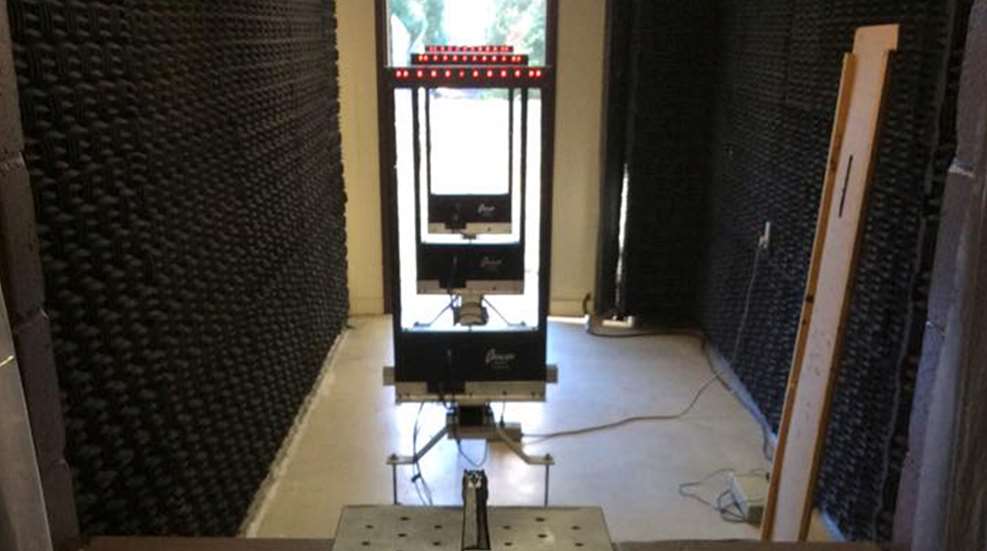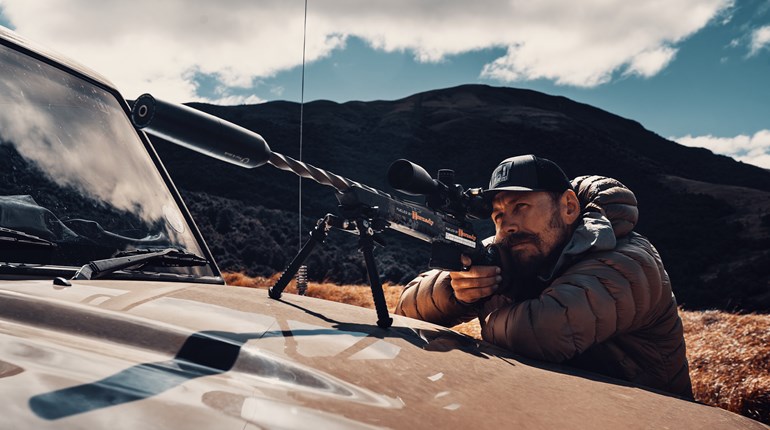
WARNING: All technical data in this publication, especially for handloading, reflect the limited experience of individuals using specific tools, products, equipment and components under specific conditions and circumstances not necessarily reported in the article and over which the National Rifle Association (NRA) has no control. The data has not otherwise been tested or verified by the NRA. The NRA, its agents, officers and employees accept no responsibility for the results obtained by persons using such data and disclaim all liability for any consequential injuries or damages.
Above: The Army Marksmanship Unit’s primary chronograph, located on an indoor/outdoor 300 yard test range. It gives velocities at the target as well as at the muzzle. This facilitates calculating highly-accurate B.C.’s (ballistic coefficients) and external ballistic data for our ammunition, as fired from our rifles.
In this article, the U.S. Army Marksmanship Unit (AMU) discusses testing handloads for Service and Match Rifles. Previous articles in this series included the background and theory of testing with scopes and iron sights, the importance of sight alignment vs. sight picture, and choosing optimum target sizes for best accuracy in testing. Then, we covered various aspects of the aiming method. Those who missed these earlier articles may find them helpful. A brief review from our article on accuracy testing, reiterated below, will set the stage for chronograph sample sizes.
Statistics: Group Sizes, Distances and Sample Sizes
How many groups should we fire, and how many shots per group? These questions are matters of judgment, to a degree. First, to best assess how one’s ammunition will perform in competition, it should be test-fired at the actual distance for which it will be used. i.e., 600 or 1000 yard ammo should be tested at 600 and 1000 yards, respectively, if possible.
It is possible to work up very accurate ammunition at 100 or 200 yards that does not perform well as ranges increase. Sometimes, a change in powder type can correct this and produce a load that really shines at longer range.
The number of shots fired per group should be realistic for the course of fire. That is, if one will be firing 10-shot strings in competition then final accuracy testing, at least, should involve 10-shot strings. These will reflect the rifles’ true capability. Knowing this will help the shooter better decide in competition whether a shot requires a sight adjustment, or if it merely struck within the normal accuracy radius of his rifle.
How many groups are needed for a valid test? Here, much depends on the precision with which one can gather the accuracy data. If shooting from a machine rest in good weather conditions, two or three 10-shot groups at full distance may be very adequate. If it’s windy, the rifle or ammunition are marginal, or the shooter is not confident in his ability to consistently fire every shot accurately, then a few more groups may give a better picture of the rifle’s true average.
Initial Chronograph Setup
A chronograph is an instrument designed to measure bullet velocity. Typically, the bullet casts a shadow as it passes over two electronic sensors placed a given distance apart. The first screen is the “start” screen, and it triggers an internal, high-speed counter. As the bullet passes the second, or “stop” screen, the counter is stopped. Then, appropriate math of time vs. distance traveled reveals the bullet’s velocity. Most home chronographs use either two foot or four foot spacing between sensors. Longer spacing can add some accuracy to the system, but with high-quality chronographs, four foot spacing is certainly adequate.
Laboratory chronographs usually have six feet or more between sensors. Depending upon the make and model of one’s chronograph, it should come with instructions on how far the “start” screen should be placed from one’s muzzle. Other details include adequate light (indoors or outdoors), light diffusers over the sensors as needed, and protecting the start screen from blast and debris such as shotgun wads, etc. When assembling a sky-screen system, the spacing between sensors must be extremely accurate to allow correct velocity readings.
Preliminary Load Development and Velocities
When developing a load for one’s firearm, a chronograph is a very useful tool. Naturally, it tells the bullet speed, allowing ballistic calculations for wind deflection and trajectory, as well as velocity variation. It can also be used, in conjunction with recent handloading manuals, as an indirect indicator of pressure.
Differences between individual barrels, chamber throats, and powder lots, plus many other variables, can cause results to differ from those cited in the manuals. Thus, beware the notion of a “magical high-speed barrel.”
Suppose the manual states that their 26-inch .260 barrel achieved 2900 FPS with X bullet, Y powder, Z case and W primer. If you achieve that speed with identical components in *your* 26-inch barrel while using 5 grains less powder, that should raise a red flag.
Pressures may be at or near maximum in your rifle, despite the higher “maximum” charge cited in the manual. Observe for pressure indicators as discussed in your manuals, and never exceed published maximum powder charges.
When working up a potential match load for your rifle, it is wise to survey at least two to three current factory sources of data for your powder/bullet combination. This will give you a sense of the variations possible due to random factors. Then, beginning at a safe, listed “starting” powder charge, work your way up in increasing powder increments while shooting over the chronograph. Also, assess your brass and rifle for signs of increasing pressure.
What size powder increments should be used? This depends on the case volume and powder chosen. A 0.3-grain or 0.5-grain increase in powder charge may be significant in a .223, but of little consequence in a .300 Magnum. Faster burning powders are more sensitive to small changes in powder charge, increasing pressures more rapidly than slow-burning powders. For .308-sized cases, 0.5 grains is a safe increment until one nears maximum pressures.
Chronograph Sample Sizes
How many shots should one fire to obtain an accurate velocity for each powder charge increment when loading? That depends in part on the uniformity of velocities given by your particular powder/bullet/barrel combination.
For example: a 3- or 5-shot sample gives an extreme spread (ES) of 140 FPS between the high and low velocities recorded. The lack of uniformity indicates that firing one or two shots over the chronograph to check a powder charge is likely to give a wide margin of error.
In such a case, larger sample sizes will give a better idea of the true, average velocity. While approaching the loading manual’s listed maximum charge, track the ascending velocities per charge increment. One may well see that as charges approach maximum, velocities may become much more uniform. Moreover, velocity gains per increment of increase often become smaller.
Ideally, one won’t encounter velocity variations this large; changing primers and/or neck tension may increase uniformity. If wide variations persist, however, a different powder may offer great improvement.
Consider this: a 2-shot scan gives double the data of a one-shot sample. A 4-shot sample gives twice the data of a 2-shot scan. Larger samples are particularly useful if there is much velocity variation in the population. On the other hand, one might already be familiar with a particular powder/bullet combination in one’s barrel. If it is known to have little variation, a 1 or 2-shot scan in the early stages while working up toward the maximum can be useful, while saving expensive bullets.
As powder charges approach their maximum, some like to test accuracy while shooting over the chronograph. Although it’s a bit trickier to set up the bench, chronograph and target, this does yield more data per bullets expended. In such an instance, 5-shot or even 10-shot groups may be desirable at times.
However, once you arrive at a load combination intended for competition use, you should chronograph *at least* a 10-shot sample. This gives a reasonable picture both of the load’s uniformity and its average velocity. For long-range use, a 20-shot sample of one’s finalized match load is even better. This accurately shows the uniformity of one’s velocities over time. It is more likely to reveal any rare shots that develop velocities significantly different from the average.
In our next article, we will conclude our discussion of chronograph testing and evaluating handloads for Service and Match Rifles.
SSUSA thanks the U.S. Army Marksmanship Unit for allowing the reprint of this article.

































